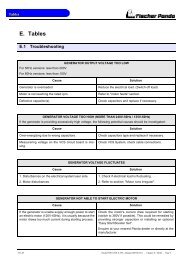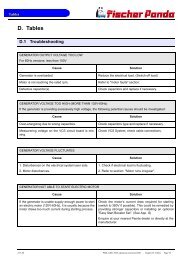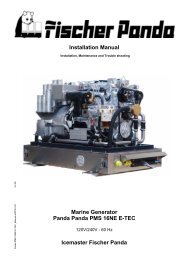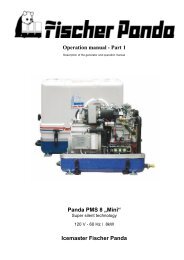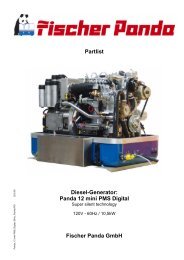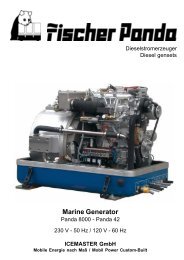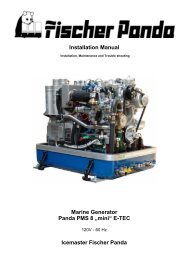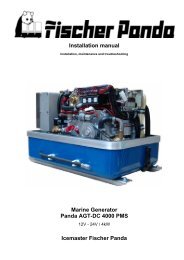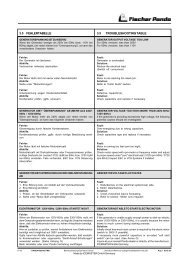Manual
Manual
Manual
Create successful ePaper yourself
Turn your PDF publications into a flip-book with our unique Google optimized e-Paper software.
General Instructions and Regulations<br />
1.6.1.1 Protective conductor and potential equalisation:<br />
Electric current below 48 V may be life-threatening. Fort this reason systems are grounded with a protective<br />
conductor. In connection with a RCD the current supply will be disconnected in case of a failure.<br />
Appropriate safety precautions like the RCD and corresponding fuses have to be provided by the customer<br />
to guarantee a save operation of the generator.<br />
1.6.1.2 Protective conductor for Panda AC generators:<br />
The generator is „earthed“ as a standard (centre and ground are interconnected in the generator<br />
terminal box by a shunt). This is a basic first-level safety measure, which offers protection as long<br />
as no other measures are installed. Above all, it is designed for delivery and a possible test run.<br />
This „neutralisation“ (Protective Earthing Neutral - PEN) is only effective if all parts of the electrical<br />
system are jointly „earthed“ to a common potential. The shunt can be removed if this is necessary<br />
for technical reasons and another protective system has been set up instead.<br />
While the generator is being operated, the full voltage is applied to the AC control box, as<br />
well. Therefore, it is essential to ensure that the control box is closed and secured against<br />
touch while the generator is running.<br />
The battery must always be disconnected if work on the generator or electrical system is to<br />
be carried out, so that the generator cannot be started up unintentionally.<br />
1.6.1.3 Switch off all loads while working on the generator<br />
All loads must be disconnected prior to working on the generator to avoid damage to the devices. In addition, the<br />
semiconductor relays in the AC control box must be disconnected in order to avoid the booster capacitors being<br />
activated during set-up. The negative terminal of the battery must be disconnected.<br />
Capacitors are required to run the generator. These have two varying functions:<br />
A) The working capacitors<br />
B) The booster capacitors<br />
Both groups are located in a separate AC control box.<br />
Capacitors store electrical energy. High voltages may remain across the capacitor contacts even after they have<br />
been disconnected from the mains. As a safety precaution, do not touch the contacts. If the capacitors must be<br />
replaced or inspected, the contacts shall be short-circuited by connecting an electrical conductor to discharge<br />
potentially remaining potential differences.<br />
If the generator is switched off normally, the working capacitors are automatically discharged via the winding of the<br />
generator. The booster capacitors are discharged by means of internal discharge resistors.<br />
For safety reasons, all capacitors must be discharged through short-circuiting before work is carried out on the AC<br />
control box.<br />
1.6.1.4 Potential equalisation for Panda AGT DC generators<br />
For further information specific to your generator, see the chapter installation.<br />
7.5.12 Kapitel/Chapter 1: General Instructions and Regulations - Seite/Page 19



